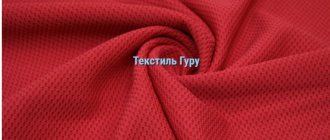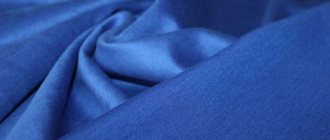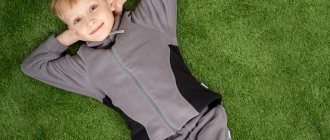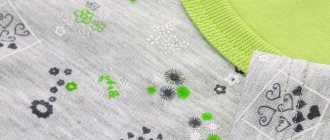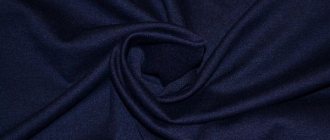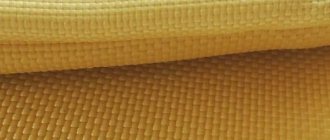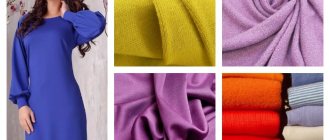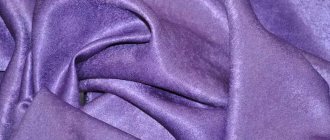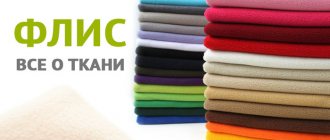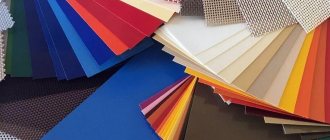DescriptionOrigin
Academician is a medium-density knitted fabric, which can be mixed or single-component in composition. Academician, or as it is also called, Milano knitwear, is a premium material and is often used for sewing expensive dresses and elegant suits.
Features a smooth matte surface. The fabric is tactilely pleasant, moderately dense and soft. This type of fabric is most often painted in neutral, calm tones of gray, beige, milky and black. However, some canvases have a brighter and more colorful design, sometimes with a printed pattern.
Like all knitted fabrics, academician fabric is made using a knitting machine, using polyester and viscose threads in approximately equal proportions. Loops of synthetic threads are woven using a special method on a knitting machine. In some cases, a small amount of natural cotton fibers is added to artificial raw materials. This makes the fabric more comfortable to wear. The finished fabric is dyed and dried.
This type of knitwear is significantly different in appearance from many other knitted fabrics. Academician always has a perfectly flat, smooth matte surface that is not prone to pellet formation.
For the first time, the material was produced in Italy, and the fabric received its second name - Milano - in honor of the famous Italian city of Milan. Initially, only famous Italian designers used the material in their works, but over time, the canvas became available to everyone.
Application
Academic knitwear was created as an expensive premium material. This is how it remains today and is therefore used mainly for sewing expensive items of men's and women's wardrobe. The practicality and durability of this material allows products made from it to be used as stylish everyday clothing.
Academician is used for the manufacture of:
- dresses, skirts, blouses;
- trousers and formal shirts;
- suits and jackets;
- jackets and cardigans;
- curtains and drapes;
- bedspread
In addition to sewing clothes, this fabric is also used to decorate home interiors. Practical fabric is used to create luxurious drapes and curtains, sew bedspreads for furniture and covers for sofa cushions.
Many designers and fashion designers decorate their collections with this fabric, successfully combining the expensive material with other fabrics, including suede, velor and corduroy.
- Equipment
- Instructions
Where is it used?
Milano knitwear is considered universal in use. It is used to make practical and attractive clothing for adults and children. The abundance of shades, textures and compositions allows you to use it for things for various purposes:
- light and warm dresses and suits
- jackets
- tunics
- coat
- cardigans
- trouser sets
- treggings
- hats and gloves
Seasonality of use depends on density.
Due to the density, the finishing elements are voluminous and textured. Milano looks beautiful in ruffles, gathers and pleats. The ability to hold its shape makes it possible to sew tight-fitting things from it, as well as curtains, bedspreads, furniture covers, and home textiles for various purposes.
Thin fabric made of silk and viscose with the addition of spandex is used for underwear. For summer dresses, blouses, and T-shirts, light and elegant Roma knitwear is used, consisting of cotton and viscose fibers. The addition of elastane to the fabric will ensure a good fit.
Milano punto is recognized as the most beautiful. It is delicate, elastic and elegant. Designed for everyday and dressy items for women's and children's wardrobes. Suits, blouses, knee socks, dresses, and leggings are made from it. Punto is available in several types depending on the thickness of the fabric and composition, so it is suitable for products for any season.
Academician and jersey material is used to sew warm dresses with closed collars, suits, cardigans, tunics, jackets and trousers. Thick knitwear with wool fibers is used for demi-season outerwear. Such things are cozy, warm and beautiful.
Milano attracts consumers with its comfort to wear and durability. I use it to make elegant, classic clothes with a simple cut that will last for several years.
Care
Products made from this fabric do not require complex care or dry cleaning. They can be easily washed in a washing machine without losing their shape. Colored items will remain just as bright, since the canvas is well dyed with high-quality dyes, which subsequently do not wash out or fade in the sun.
| Characteristics of care | Recommendation |
| Washable with other materials | Not acceptable |
| Washing clothes of different colors | Not acceptable |
| Washing temperature | 30-40 °C |
| Washing time | 1 hour |
| Requirements for cleaning products | Do not bleach. Do not use products with chlorine. Wash with soft gel or any liquid detergent |
| Spin mode | 10 minutes at medium speed |
| Ironing mode | Iron from the inside out at a temperature of 130-150 °C. The item can be steamed |
| Storage Features | Products made from this type of knitwear can be stored folded on a hanger or on a shelf. The storage location should be well ventilated, dry and dark |
| Dry cleaning | Not acceptable |
- Equipment
- Facilities
Washed items should be placed horizontally on a drying board, never hanging them on a hanger or hanger, as this may stretch the fabric.
When ironing the fabric, you should, if possible, reduce the duration of contact of the iron with the material. You should try to smooth the fabric with quick, gentle movements, applying and removing the soleplate of the iron, without stretching or deforming the fabric.
Milano knitwear: what kind of fabric, reviews
Tatyana “I sewed my first “non-purchase” product from Milano. My old, favorite dress was worn out, but I couldn’t find anything similar in stores, although the cut was basic. I took it and tore it open. It was with these “spare parts” that I sewed: I pinned it onto new fabric, cut it out, and off I went. I remember that this knitwear was very easy to work with. It doesn't crumble at all and holds its shape well. Literally got it done in one evening.”
Irina “I have long wanted a high-waisted pencil skirt. But no matter how much I tried it on, I liked the way it looked, but the way it felt on myself, I didn’t. And they advised me to pay attention to Milano knitwear; I didn’t know what kind of fabric it was then. I went and felt it and liked it. In the end, I bought a cut and sewed it to order. I really like the skirt, it fits well, doesn’t pinch when I sit down, and doesn’t stretch out.”
Milano fabric reviews
Nina “Mom had doubts at one time, she got used to things that didn’t stretch “to go out.” I scoured the entire Internet on the topic of “Milano fabric”, what it is, its composition, and read reviews. And now I’m hooked on sheath dresses made from it. She has several of them, different colors and cuts. He chooses a monochromatic material so that you can complement the item with any accessories and not bother with the fact that “the dress already has a pattern, where else would a colorful scarf be.” They wear for a long time, there are no pills or snags.”
Svetlana “Oh, this is my salvation for the fall. It’s always cool in the office, but I don’t like shawl sweaters, I don’t like it when I’m wearing a hundred layers. That's why wool blend jersey is my everything. I buy tunics from it, dresses with sleeves. Warm, comfortable and beautiful. I’m also looking at a trouser suit, but jersey trousers are embarrassing. Will they be wiped in strategic places..."
Compound
With different options for mixing components, various types of fabric are obtained that have a specific structure and personal name. The same type of material contains different percentages of one or another component.
The composition of Milano fabric in various proportions includes:
- natural fibers (cotton, wool, silk);
- artificial materials (viscose);
- synthetic (nylon, polyamide, polyester, elastane).
Note! When purchasing, do not confuse two completely different materials - Milano knitwear with the same name as high-quality velor for furniture upholstery, also called “Milan” or “Milan”.
Description
The fabric has several types of thread weave. It may contain synthetic and natural fibers; this should be indicated on the label of the purchased clothing. Products made from it have a beautiful and elegant appearance, their surface is smooth and elastic. Plus, it comes in rich shades. With its high density, it fits perfectly to the figure.
- Milano fabric: description and reviews of knitwear with an Italian name
This knitwear retains its shape and color even after numerous washes. Unlike similar knitwear, this one is made much denser, but it is better to wash it at a temperature of less than 30 degrees.
Milano fabric is soft and pleasant to the body, it wears perfectly.
Follow the link to find a description of microdiving fabric.
See photo of ribana fabric.
Memory fabric is very popular. Here's a photo: .
Material composition
There are two materials under this name:
- Milano is a type of high quality velor used for upholstering furniture. Reviews of velor furniture fabric can be found here.
Presented in an original range of colors and endowed with European quality. It has an expensive and luxurious appearance, withstands exposure to the sun and is not susceptible to external factors.
- Milano is used to make clothes for people of all ages. Most often, its composition is mixed, represented by polyester, cotton and elastane, or completely synthetic. Most often, products made from this fabric are worn in winter, but there are also thinner pieces that can be worn in summer.
Milano can contain: wool, silk, polyester, spandex, elastane, viscose and cotton, but most often it is mixed. In such fabrics, thick threads predominate, their weave is quite dense, and when cutting the product, the threads do not fray. They are made both plain and printed.
Types of jersey: Academician, Jersey, Roma, Punto
It has several varieties, which differ in the thickness of the canvas, external design and raw materials; the following types are distinguished:
- Academician - a larger percentage of this fabric consists of viscose.
- Jersey is a dense classic knitwear consisting primarily of wool fibers.
- Roma - it contains cotton, the fabric is the thinnest of all Milano varieties.
- Punto - polyester predominates in it, this type is the most common when sewing clothes. The composition and properties of polyester fabric can be viewed here.
Characteristics of knitted fabric
Milano is pleasant to the body and soft, and also perfectly absorbs moisture, but not only this makes it different from other knitwear, but also:
- High strength . It withstands numerous washes and stretches. It has high elasticity, behaves like gin, without stretching even with prolonged wear. Can withstand strong mechanical forces.
- Elasticity . It is achieved in this fabric due to the unique weave of fibers.
- Colors and prints . Manufacturers can apply any design to the fabric and make it unique. A lot of its copies are presented in bright and rich colors.
- Elasticity. The fabric does not deform or wrinkle, and retains its original appearance for a long time.
- Softness and comfort. Clothes made from this material do not prick or pinch.
- Easy to care for. The material does not accumulate dust; a product made from it can be worn for several days in a row, since the fabric does not stain.
The surface of the material is protected from accidental stains, since drops simply roll off it. It's nice to walk in it all day.
- Peñe is a practical knitwear with an impeccably smooth surface for making comfortable, beautiful things
In the video - Milano fabric:
What types are produced
There are 5 types of Milano knitwear produced in large quantities, which can be seen in the photo. They differ in thickness, type of raw material and features of external qualities:
- Punto is the most popular type of this knitwear. Mixed fabric made of natural fibers and synthetics with a high polyester content. There may also be some percentage of viscose in the fabric. The fabric is bi-elastic, with minimal stretch along the length. The width stretches perfectly and returns to its original state due to its elasticity.
- Jersey is a long-familiar thick knitwear, in a classic form containing wool and silk fibers. The name jersey is of English origin and was once a thick, coarse material made from 100% wool. Silk material will be light and thin, and woolen material will be used for outerwear
- Roma is a thin, silky fabric that includes cotton, viscose and polyester in various combinations. It is bi-elastic and stretches in both directions. Available in both matte and shiny.
- Academician - warm knitwear with a high percentage of viscose or polyester in the composition, possibly an equal ratio. Durable, matte material.
- Premium – suit Milano in beautiful shades. Quite thick and with a little hairiness on the front side. Stretches moderately and maintains the shape of the product. Ideal for a sheath dress. Contains a high percentage of viscose, which increases the tendency to shrink. Before cutting, heat with an iron and steam is necessary.
Advantages and disadvantages
This material has gained great popularity and fame due to its elegant appearance, practicality, strength and softness. However, like any fabric, Milano has some disadvantages that are important to keep in mind.
Pros:
- beautiful appearance;
- pleasant tactile sensations;
- softness;
- strength;
- wear resistance;
- elasticity;
- ease of care;
- hygroscopicity;
- breathability;
- low creasing;
- does not attract dust and is little dirty;
- the material is not translucent, which allows you to sew it without a lining.
Minuses:
- high price;
- synthetic composition can cause allergies;
- Difficulty in working with fabric when sewing.
A separate advantage of this canvas is its versatility. So, you can make festive, office and everyday outfits from Milano fabric. Moreover, the style can be any - both loose and fitted, due to the elasticity and elasticity of the material.
Attractive material qualities
- Wide selection of colors and patterns.
- Excellent aesthetic characteristics.
- Softness and comfort to wear.
- High elasticity, especially when adding spandex and lycra fibers.
- Density and lack of creasing.
- Keeps you warm.
- Thin fabric does not show through when stretched.
- Provides air exchange even with sufficient density.
- Keeps its shape well.
- Fits beautifully in the product with voluminous folds.
- Gives the desired fit.
- Durability.
- Resistance to damage.
- Affordable cost and easy maintenance.
